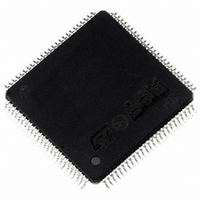ST92F150CV1TB STMicroelectronics, ST92F150CV1TB Datasheet - Page 116

ST92F150CV1TB
Manufacturer Part Number
ST92F150CV1TB
Description
MCU 8BIT 128K FLASH 100TQFP
Manufacturer
STMicroelectronics
Series
ST9r
Datasheet
1.ST92F150CV1TB.pdf
(429 pages)
Specifications of ST92F150CV1TB
Core Processor
ST9
Core Size
8/16-Bit
Speed
24MHz
Connectivity
CAN, EBI/EMI, I²C, LIN, SCI, SPI
Peripherals
DMA, LVD, POR, PWM, WDT
Number Of I /o
77
Program Memory Size
128KB (128K x 8)
Program Memory Type
FLASH
Eeprom Size
1K x 8
Ram Size
4K x 8
Voltage - Supply (vcc/vdd)
4.5 V ~ 5.5 V
Data Converters
A/D 16x10b
Oscillator Type
Internal
Operating Temperature
-40°C ~ 105°C
Package / Case
100-TQFP, 100-VQFP
Processor Series
ST92F15x
Core
ST9
Data Bus Width
8 bit, 16 bit
Data Ram Size
6 KB
Interface Type
CAN, I2C, SCI, SPI
Maximum Clock Frequency
24 MHz
Number Of Programmable I/os
80
Number Of Timers
5 x 16 bit
Operating Supply Voltage
4.5 V to 5.5 V
Maximum Operating Temperature
+ 105 C
Mounting Style
SMD/SMT
Development Tools By Supplier
ST92F150-EPB
Minimum Operating Temperature
- 40 C
On-chip Adc
16 bit x 10 bit
Lead Free Status / RoHS Status
Lead free / RoHS Compliant
Other names
497-4883
Available stocks
Company
Part Number
Manufacturer
Quantity
Price
Company:
Part Number:
ST92F150CV1TB
Manufacturer:
STMicroelectronics
Quantity:
10 000
- Current page: 116 of 429
- Download datasheet (8Mb)
ST92F124/F150/F250 - INTERRUPTS
WAKE-UP / INTERRUPT LINES MANAGEMENT UNIT (Cont’d)
5.12.3.4 NMI Pin Management
On the CPU side, if TLTEV=1 (Top Level Trigger
Event, bit 3 of register R246, page 0) then a rising
edge on the NMI pin will set the TLIP bit (Top Level
Interrupt Pending bit, R230.6). At this point an in-
terrupt request to the CPU is given either if TL-
NM=1 (Top Level Not Maskable bit, R247.7 - once
set it can only be cleared by RESET) or if TLI=1
and IEN=1 (bits R230.5, R230.4).
Assuming that the application uses a non-maska-
ble Top Level Interrupt (TLNM=1): in this case,
whenever a rising edge occurs on the NMI pin, the
related service routine will be executed. To service
further Top Level Interrupt Requests, it is neces-
sary to generate a new rising edge on the external
NMI pin.
The following summarizes some typical cases:
– If the ST9 is in STOP mode and a rising edge on
116/429
9
the NMI pin occurs, the ST9 will exit STOP
mode and the NMI service routine will be exe-
cuted.
– If the ST9 is in Run mode and a rising edge oc-
– If the ST9 is in run mode and a rising edge on
– If the ST9 is in run mode and the NMI pin is high:
curs on the NMI pin: the NMI service routine is
executed and then the ST9 restarts the execu-
tion of the main program. Now, suppose that
the user wants to enter STOP mode with NMI
still at 1. The ST9 will not enter STOP mode
and it will not execute an NMI routine be-
cause there were no transitions on the exter-
nal NMI line.
NMI pin occurs during the STOP bit setting se-
quence: the NMI interrupt will be acknowledged
and the ST9 will not enter STOP mode. At the
end of the NMI routine, the user must re-enter
the sequence: if NMI is still high at the end of the
sequence, the ST9 can not enter STOP mode
(see previous case).
if NMI is forced low just before the third write in-
struction of the STOP bit setting sequence then
the ST9 will enter STOP mode.
Related parts for ST92F150CV1TB
Image
Part Number
Description
Manufacturer
Datasheet
Request
R

Part Number:
Description:
BOARD PROGRAM FOR ST92F150 MCU
Manufacturer:
STMicroelectronics
Datasheet:

Part Number:
Description:
BOARD EVALUATION FOR ST9 SERIES
Manufacturer:
STMicroelectronics
Datasheet:

Part Number:
Description:
BOARD EMULATOR FOR ST9 SERIES
Manufacturer:
STMicroelectronics
Datasheet:

Part Number:
Description:
MCU, MPU & DSP Development Tools ST9 Dedication Board
Manufacturer:
STMicroelectronics
Datasheet:

Part Number:
Description:
STMicroelectronics [RIPPLE-CARRY BINARY COUNTER/DIVIDERS]
Manufacturer:
STMicroelectronics
Datasheet:

Part Number:
Description:
STMicroelectronics [LIQUID-CRYSTAL DISPLAY DRIVERS]
Manufacturer:
STMicroelectronics
Datasheet:

Part Number:
Description:
BOARD EVAL FOR MEMS SENSORS
Manufacturer:
STMicroelectronics
Datasheet:

Part Number:
Description:
NPN TRANSISTOR POWER MODULE
Manufacturer:
STMicroelectronics
Datasheet:

Part Number:
Description:
TURBOSWITCH ULTRA-FAST HIGH VOLTAGE DIODE
Manufacturer:
STMicroelectronics
Datasheet:

Part Number:
Description:
Manufacturer:
STMicroelectronics
Datasheet:

Part Number:
Description:
DIODE / SCR MODULE
Manufacturer:
STMicroelectronics
Datasheet:

Part Number:
Description:
DIODE / SCR MODULE
Manufacturer:
STMicroelectronics
Datasheet:











